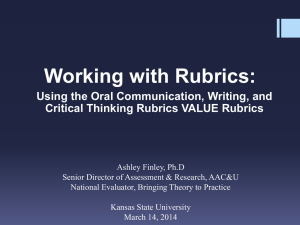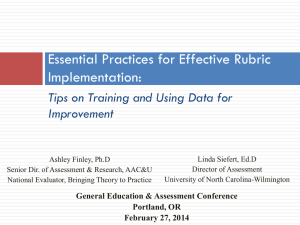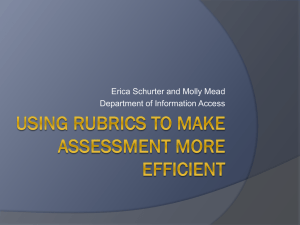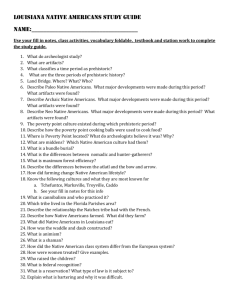General Education Learning Outcomes Assessment Pilot Spring 2013
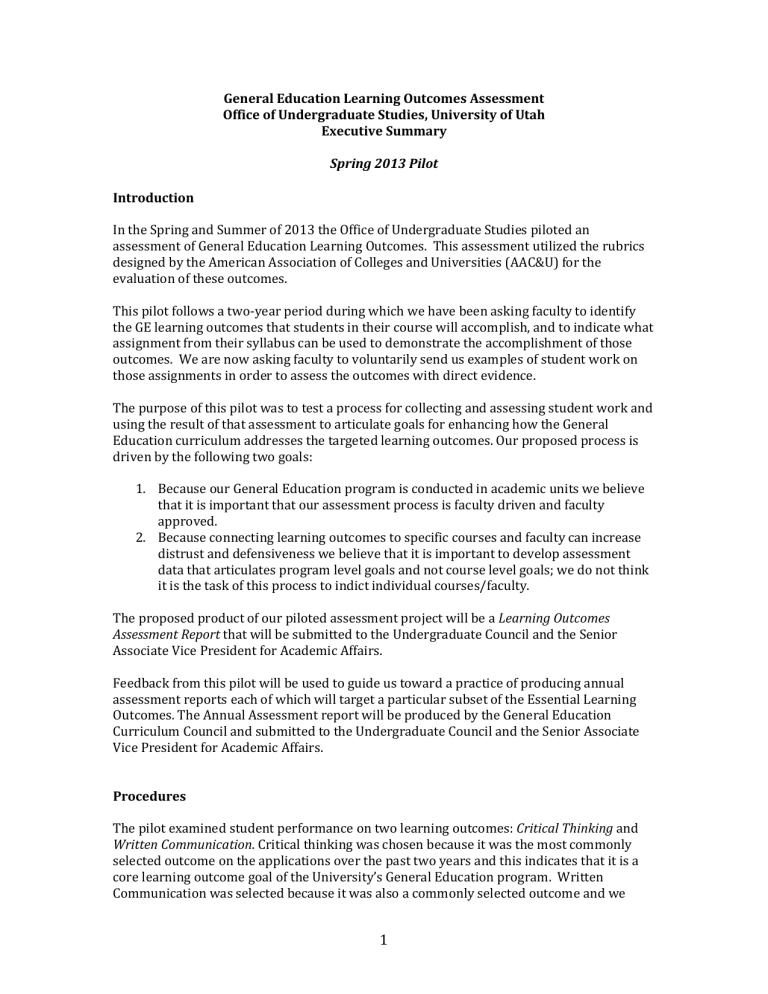
General Education Learning Outcomes Assessment
Office of Undergraduate Studies, University of Utah
Executive Summary
Spring 2013 Pilot
Introduction
In the Spring and Summer of 2013 the Office of Undergraduate Studies piloted an assessment of General Education Learning Outcomes. This assessment utilized the rubrics designed by the American Association of Colleges and Universities (AAC&U) for the evaluation of these outcomes.
This pilot follows a two-year period during which we have been asking faculty to identify the GE learning outcomes that students in their course will accomplish, and to indicate what assignment from their syllabus can be used to demonstrate the accomplishment of those outcomes. We are now asking faculty to voluntarily send us examples of student work on those assignments in order to assess the outcomes with direct evidence.
The purpose of this pilot was to test a process for collecting and assessing student work and using the result of that assessment to articulate goals for enhancing how the General
Education curriculum addresses the targeted learning outcomes. Our proposed process is driven by the following two goals:
1.
Because our General Education program is conducted in academic units we believe that it is important that our assessment process is faculty driven and faculty approved.
2.
Because connecting learning outcomes to specific courses and faculty can increase distrust and defensiveness we believe that it is important to develop assessment data that articulates program level goals and not course level goals; we do not think it is the task of this process to indict individual courses/faculty.
The proposed product of our piloted assessment project will be a Learning Outcomes
Assessment Report that will be submitted to the Undergraduate Council and the Senior
Associate Vice President for Academic Affairs.
Feedback from this pilot will be used to guide us toward a practice of producing annual assessment reports each of which will target a particular subset of the Essential Learning
Outcomes. The Annual Assessment report will be produced by the General Education
Curriculum Council and submitted to the Undergraduate Council and the Senior Associate
Vice President for Academic Affairs.
Procedures
The pilot examined student performance on two learning outcomes: Critical Thinking and
Written Communication. Critical thinking was chosen because it was the most commonly selected outcome on the applications over the past two years and this indicates that it is a core learning outcome goal of the University’s General Education program. Written
Communication was selected because it was also a commonly selected outcome and we
1
hoped to collaborate with the assessment of writing already conducted by the University
Writing Program (now the Department of Writing and Rhetoric Studies).
On March 11, 2013 a letter and corresponding email invited faculty to participate in the pilot who had selected Critical Thinking or Written Communication on the General
Education application over the past two years. Faculty were asked to submit four artifacts of student work with one demonstrating high performance, two representing average performance, and one representing poor performance. Faculty were not asked to identify the course from which this artifact was derived to emphasize the separation between course evaluation processes and learning outcome assessment. The letter provided instructions on how to upload artifacts of student performance related to the targeted learning outcomes. Between March 11 and June 10, 57 artifacts from 15 faculty members were collected. Student names were extracted from all samples before making these available to the faculty review committees.
A different group of faculty were invited to participate as reviewers of student performance.
These individuals had participated in the General Education course review process and were familiar with the designations and their criteria. Nine faculty from seven different departments accepted that invitation and were compensated for their labor by the Office of
Undergraduate Studies. These individuals were put into three teams of two and one team of three and each team reviewed six artifacts of student work. Two teams reviewed Written
Communication and two teams reviewed Critical Thinking artifacts.
Each team was asked to use the provided rubrics to rate each artifact individually and then meet together to identify a common rating. All ratings were submitted to Mark St. Andre in the Office of Undergraduate Studies who tabulated and summarized the results. These summarized ratings were used to facilitate a final discussion with the group of raters. The purpose of this final discussion was to generate the following two types of recommendations:
1.
Given these ratings, what recommendations do you make to the Office of General
Education in the Office of Undergraduate Studies about our students’ performance on these learning outcomes?
2.
Given this process, what recommendations do you make to the Office of General
Results
Education about how to proceed with a larger scale pilot?
The pilot produced two data points: a common score for each criterion of the rubric, and comments from each team about the process they went through in applying the rubrics to the student artifacts. The two figures below show the average score for each of the five criteria in each of the two rubrics –Written Communication and Critical Thinking. Written
Communication scores ranged from 1.8 to 2.2 on a 4-point scale. This means that the artifacts reviewed demonstrated students performing at the first milestone level. Critical
Thinking scores ranged from 1.7 to 2.2 on a four-point scale. Thus, artifacts reviewed for critical thinking also demonstrated students performing at the first milestone level.
Recognizing that this is a first pilot and we lack baseline scores, these findings did invite the reviewers to ask questions about the course levels from which the artifacts had come and whether or not we expect student performance to rise above the first milestone in the
General Education curriculum.
2
These scores are the result of a pilot in which we were testing out a new rubric and a new process and there are no historical scores with which to compare these figures. As we move this process forward and begin to implement learning outcomes review across General
Education we will develop meaningful baseline rubric scores. This will allow us to compare progress on targeted learning outcomes from one review period to another.
Discussions of using these rubrics also focused on the match (or lack thereof) between the assignment given and the rubric used to evaluate that artifact. Through the process of collecting data based on rubric review of artifacts we are likely to learn what kinds of assignments are more appropriate for enabling students to show their accomplishment of certain outcomes.
Summer 2013 Pilot - Written Communication Rubric Scores
Average Across All Artifacts (n=12)
Rubric Scale 0-4
Control of Syntax & Mechanics
Sources and Evidence
Genre & Disciplinary Conventions
Content Development
Context & Purpose of Writing
0,0 0,5 1,0 1,5
1,8
1,8
2,1
2,1
2,0
2,2
2,5
3
Summer 2013 Pilot - Critical Thinking Rubric Criteria Scores
Average Across All Artifacts (n=12)
Rubric Scale of 0-4
Conclusions & related outcomes 2,1
Student's position 2,2
Influence of context & assumptions
Evidence
1,7
2,0
Explanation of Issues 1,8
0,0 0,5 1,0 1,5 2,0 2,5
The proposed Annual Report produced by the General Education Curriculum Council will show average scores for the criteria of each the rubrics for the learning outcomes that are being assessed that year. In addition, the report will include observations about the accomplishment of the relevant learning outcome in the General Education curriculum based on the average rubric scores as well as comments from the review team about the artifacts that they reviewed.
Feedback
Our colleagues supported the general outline of the review process that we are proposing and gave us helpful feedback to use as we move forward with a larger scale pilot. That feedback is summarized in the following points:
Provide training that focuses on the use of the rubrics.
Create a step for rubric modification/contextualization.
With adequate training, two review steps are unnecessary. Individual reviews are sufficient.
With adequate training, faculty can review up to ten artifacts during a single review cycle.
Reviewers felt information about the course (especially course level) in which the work was submitted was critical to making sound rating decisions.
4
Faculty should be asked to submit 10% of the student work submitted in response to the assignment attached to the targeted learning outcome. All of the work submitted should be above average performance.
Encourage faculty to use rubrics when they design assignments in courses that carry
General Education designations.
Encourage faculty to target fewer learning outcomes but to address them thoroughly.
Design a feedback loop for faculty that is not attached to General Education course review processes.
Next Steps
This report will be submitted to the General Education Curriculum Council, the
Undergraduate Council, and the Senior Vice President of Academic Affairs in the Fall of
2013.
We are planning an expanded pilot that will take place during the 2013-14 Academic Year.
In this pilot we will still target Critical Thinking and Written Communication. We will collect
120 artifacts of student performance (60 for each learning outcome). The General Education
Curriculum Council will review these artifacts and prepare an Assessment Report that will be submitted to the Undergraduate Council and the Senior Associate Vice President for
Academic Affairs. Artifacts will be collected in the Fall and reviewed in the Spring.
During the Fall semester a small subset of the Undergraduate Council will review the rubrics for Critical Thinking and Written Communication in order to more carefully contextualize those to the work of various disciplines contributing to General Education.
Training in the use of these rubrics will also be designed in the Fall semester.
